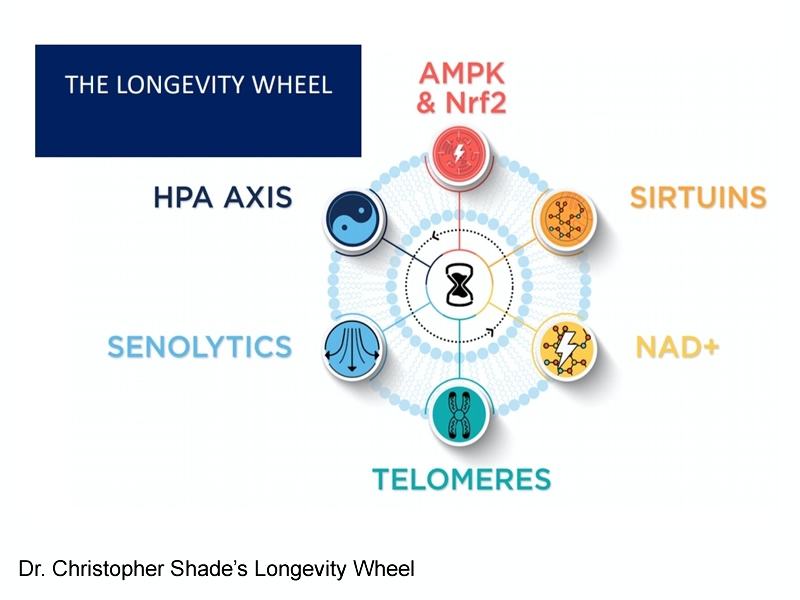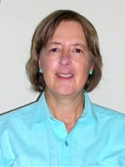The Science of Longevity: Exploring the Limits of the Human Lifespan
a4mlogo.jpg

American Academy of Anti-Aging Medicine
Following are summaries of several of the presentations delivered at the 2020 A4M World Congress. Rooted in a forward-focused mission to redefine modern medicine, The American Academy of Anti-Aging Medicine (A4M) is the established global leader for continuing medical education in longevity medicine, metabolic resilience, and whole-person care.
Biohacking Tools: My Approach for Minimizing Disease Risk and for Maximizing Longevity
Michael Lustgarten, PhD
Summary by Kris Olson
Dr Lustgarten tracks biological age by working with specific systemic biomarkers, then tailoring diet, exercise, and supplementation to reduce the risk of disease and improve longevity. He has developed a complex process of following nine common markers including glucose, albumin, CRP and others, which he then updates after various interventions of diet and exercise. Although it seems like a Herculean effort to implement these different interventions and record the results, he has been able to discover which diet and lifestyle changes have the greatest impact on his personal health. Since he is a study of one, his personal plan may not work the same for others, but his research could be helpful in a future where personalized medicine can assist people in taking charge of their longevity.
Glycomics: The Next Frontier in Medicine
Helen Messier, Phd, MD
Summary by Kris Olson
Dr Messier, a pioneer in the new field of Glycomics, discussed her recent research in this exciting area that impacts many areas of disease including infection, cardiovascular disease, diabetes, kidney health, cancer metastasis, apoptosis and others. Glycomics is the study of the entire complement of sugars both as free components and parts of complex molecules. Glycolization works though 16 different pathways making use of approximately 200 different glycosyltransferases. Further research in this field can eventually lead to new indicators used for predicting various pathologies and ultimately, more specific testing markers for viruses and diseases.
Stem Cell, NK Cells and Longevity Medicine – An Update
Rafael Gonzalez, PhD
Summary by Kris Olson
There are different perspectives on defining longevity and senescence is one of them. Senescence refers to the process where cells age and stop dividing in a healthy way and the organism loses function. It is one indicator that can be used to measure the immune system and track chronic inflammation. Addressing cell senescence is important because it can improve or slow down the process of aging. Reducing senescent cells attenuates inflammation, restores cell function and slows aging. Healthy Natural Killer cells can destroy senescent cells, so their presence becomes another factor in increasing longevity. Dr. Gonzales looked at studies of healthy centarians and noted they had lower levels of inflammatory markers TNF alpha, IL6 and CRP. These markers also tracked with better cognitive abilities and mitochondrial function. He presented case studies that examined the role of mesenchymal stem cells and how they can help repair and restore mitochondria damage and improve overall health. His studies show that reducing Inflammation, senescence and mitochondrial dysfunction can play an important role in maintaining longevity.
Longevity Medicine – Patient Cases and Protocols
Joseph Cleaver, MD
Summary by Kris Olson
Dr Cleaver discussed the importance of understanding cell senescence and the role of senolytics in treating aging. He explained that cellular senescence occurs from mutations due to factors like stress, over-replication and age-related disease. He defines senolytics as agents that inhibit pathways that make senescent cells resistant to apoptosis. Senolytics can clear out damaged cells and therefore play a role in addressing many diseases related to the inflammatory process. There are many senolytics including drugs, supplements, a healthy diet, exercise, hormone therapy and peptides. He presented several studies that looked individually at some of these factors and how they increased telomere length and improved senescence.
Hacking the Power of Your Mitochondria
Dave Asprey
Summary by Kris Olson
The well-known author and biohacker, Dave Asprey, is always scoping out the latest trends in health care. He talked about how cellular health is impacted by factors like light, food, water, gravity, air, EMFs, timing, temperature and pressure and the various interventions that can help or harm the cell. Asprey was an early advocate for the keto diet, but after looking at many people’s experiences, he concedes that it is not for everyone, especially over the long term. Many people get short-term benefits from the diet but then reach a point where they feel sluggish and fatigued. He spent some time talking about different fats and noted that we need both saturated and polyunsaturated fats but that some are better than others.
Another trend on the horizon is the concept of “Food as Therapy”. He noted that some insurance companies are looking at this as an option in the treatment of diabetes, heart disease and other illnesses. Other areas of growing interest include Hyperbaric Oxygen therapy, structured water, and including small amounts of fat with water consumption. He also discussed the benefits of Calcium-d-Glucarate (CDG) in the reduction of toxins, cholesterol and improving energy.
Rethinking SIBO in the Microbiome ERA
Vincent Pedre, MD
Summary by Dr. Joanne Quinn
Most of us have heard of SIBO by now but what is it really? It is abnormal or excessive overgrowth of bacteria in the small intestine. The problem with diagnosing SIBO is the tremendous numbers of symptoms that can present. There are several ways that SIBO can occur including a basic over growth of bacteria from bad life style choices; translocation of bacteria from the colon into the small intestine; continual constipation; use of proton pump inhibiting drugs known as PPIs; hypothyroidism; vagal nerve dysfunction; pancreatic dysfunction; prior food poisoning; to mention a few. There are ways to test for SIBO including endoscopy or Breath Test measuring hydrogen and methane in the breath over a period of time. The Breath Test is far less invasive compared to endoscopy and often is the test of choice. Once SIBO is suspected and confirmed, the problem is effective treatment. Many people use the FODMAP diet but specialists are finding that alone will not solve the problem. Rifaximin has been used but is not beneficial long term. Spore based probiotics have shown benefit when used along with serum derived bovine immunoglutins (SDI). SDI’s bind to microbial antigens and limit absorption. One way to envision the synergy of these two approaches is the “Push” and “Pull” application. The spore probiotics tend to push out the bad bacteria and the SDIs pull out the toxins. Typically, digestive enzymes are added to the protocol. In addition, prokinetic activities like singing and/or gargling are beneficial. In addition, colostrum can also help with the process of binding toxins and healing the gut lining.
Peptides – The New Frontier in Medicine
James LaValle, RPH, CDN
Summary by Dr. Joanne Quinn
Chronic stress causes elevation of cortisol having a global impact on the body. The goal is allostasis but with stress causing an allostatic load the circuits blow a fuse and cannot maintain ultimately causing neuronal destruction. This wear and tear on the body can be helped with the use of peptides. First and foremost however, it is important to understand the legal environment around peptides. Each state has specific regulation and these must be investigated prior to the use of peptides. Following is an initial review of several peptides and their impact on the body.
- Semorelin: This is a synthetic GHRH growth hormone. It is used for anti-aging and typically will have a six month protocol.
- Kisspeptin: This peptide is principally used for hypogonadism, fertility and testosterone support.
- TA-1: Thymosin Alpha -1. This is a synthetic thymic peptide and helps modulate the human GUT mucosal immune system. It improves Th1/Th2 immune balance.
- Thymosin Beta-4: TB-4 is isolated from calf thymus. It is a 43 amino acid chain and lowers micro fibroblasts. It also supports immunity and can be used with TA-1.
There is a lot of research involving the use of peptides and has many applications including regulation of inflammation of the brain and other organs, blood glucose, Cardiovas D, metabolic syndrome, cognition, immune defense, cancer, aids bones and joints, addresses sleep disorders, hormone issues, growth hormone issues and performance issues for example.
Psychosurgery – From Frontal Lobotomy to Neuromodulation
Joseph Maroon, MD
Summary by Dr. Joanne Quinn
Dr. Maroon has worked in this field since the 1970s when he worked at the Central Indiana State Hospital assessing 2500 mentally ill patients. The science of mental illness and psychosis has progressed at a fast pace since then. Early on in the 1950s and 1960s bilateral lobotomy was done regularly doing great damage to the patients who received this therapy. It was barbaric and was finally outlawed. In the 1950s ablation procedures were used involving various parts of the brain for abnormalities including Parkinson’s. Amygdalotomics were next and soon discontinued. Then Deep Brain Stimulation was introduced to address many issues including pain, epilepsy and psychiatric disorders. After that came the use of neuromodulation to modulate behavior. Unfortunately pharmaceutical drugs have not proven effective in a large majority of cases so science continued to look for new answers.
Currently, practitioners are looking at Connectome therapies. The brain is analyzed as to how it is wired, looking at all levels of connections, identifying neural pathways, and identifying structure and function. Understanding brain disease is now called Connectomics. This is an etiopathologic framework which looks at neurons, synapses and fiber tracts. These networks and how they relate to issues such as autism have been very enlightening. For example, investigation has shown that stress or marijuana use during pregnancy impact the fetus and the development of these pathways. Structural abnormalities develop impacting function.
It has also become clear that learning stimulates neurogenesis and neuroplasticity in the brain helping neurons regenerate and creating new synaptic connectivity. The alteration of the nerve is known as neuromodulation. By delivering a targeted stimulus (energy source) to specific neurological sites in the body psychological pathways are influenced. There are a number of avenues to create this stimulation including magnetism (TMS), Direct Electrical Stimulation, Direct Current Stimulation, Alternating Current stimulation, Audio Visual Entrainment, Photobiomodulation, ultrasonic modulation, and Biofeedback with quantitative EEG. Brain Computer Interface is on the drawing board and would involve subcutaneous implants. The goal is to find homeostasis within the brain to modulate behavior. Dr. Maroon goes into all of these aspects in detail in his book Square One- a simple guide to a balanced life.
Gene Therapy and Aging
Dr. Bill Andrews, Medical Researcher, Molecular and Population Genetics PhD
Summary by Dr. Amanda Whittal
In this session based on experience and meta-analytic literature reviews, Dr. Bill Andrews took the audience through a summary of what essentially causes aging: telomere shortening, which occurs each time a cell divides. Prior to introducing the role of gene therapy, Dr. Andrews highlighted the key lifestyle components that can contribute to decreasing the rate of telomere shortening:
- Reduce inflammation and oxidative stress in the body (e.g. avoid inflammatory foods)
- Exercise (not excessively, ideally keeping it fun)
- Increase intake of antioxidants, omega 3 fatty acids, vitamin D
- Don’t smoke
- Maintain a healthy weight
- Decrease stress
- Reduce depression
- Reduce pessimism
With a perfect lifestyle, it is estimated that humans can live up to a maximum of 125 years.
Dr. Andrews and his team discovered telomerase, an enzyme which lengthens telomeres. Telomerase is present in all cells of animals that have undetectable aging and no telomere shortening, such as lobsters, clams, tortoises and humpback wales.
Gene therapy with telomerase, in which telomerase has been introduced to human cells, has shown positive results in terms of lengthening telomeres and potentially improving age-related issues such as reversing brain decline.
Studies are still being conducted, but current findings suggest the therapy is safe, effective and no serious side effects.
Immune Resilience
Dr. Amy Nett, MD
Summary by Dr. Amanda Whittal
Dr. Amy Nett, a medical doctor practicing functional and integrative medicine urges us to consider the often undetected toxicity bombarding our bodies on a daily basis: volatile organic compounds (VOCs) in indoor spaces, numerous compounds polluting our air due to regular use of chemical substances in society, smoke from wildfires, or heavy metals from common products, to name a few.
This toxicity can increase our vulnerability to infections by increasing inflammation in the body, hindering vascular function, increasing oxidative stress and disrupting metabolism.
Dr. Nett’s message is a reminder that we cannot eliminate exposure to toxins, but we can ensure we are aware of the most relevant sources and signs of toxicity. Signs of toxicity may include, for example, fatigue, difficulty sleeping or concentrating, digestive issues, thinning hair, joint pain, sinus issues, headaches, or anxiety.
If you suspect you’re living with excessive environmental toxicity, potential testing options include:
- Blood tests (for kidney and liver function, nutrients, inflammation)
- Gut testing (stool, breath test, organic acids)
- Urinary mycotoxin, environmental or heavy metal toxicity testing
If toxicity is an issue, a detox is recommended, focusing on exposure to clean air and water insofar as possible, a healthy diet, adequate sleep and exercise, and supportive components such as lymphatic drainage, saunas and supplements.
Her five highly recommended supplements* for support during detox include:
- Liposomal Glutathione (antioxidant)
- Curcumin (anti-inflammatory, antiviral, antioxidant)
- Fish oil (anti-inflammatory, protection from air pollution)
- Sulforaphane (activator of pathway that affects antioxidant and anti-inflammatory genes)
- Charcoal, clay, citrus/apple pectin, silica extract or chlorella (binders - bind to toxins to help remove them from the body)
*Medical professionals/product instructions should be consulted for dosing
Herbals and Supplements
Dr. Jaclyn Chasse-Smeaton, ND
Summary by Dr. Amanda Whittal
Our immune system contains an adaptive and innate component. The active immune system is managed by the spleen, thymus, bone marrow and lymph nodes, and contains T and B lymphocytes. It is slow, strong and responds to specific illnesses or toxins. The innate immune system is not managed by specific organs, and contains NK cells. It is fast, weaker, and innate, including aspects such as physical and chemical barriers (e.g. skin).
Numerous factors, such as age, lifestyle or autoimmune disease, can cause immune responses to be insufficient or excessive.
Dr. Chasse-Smeaton emphasizes that a healthy diet, adequate exercise and minimizing stress are all crucial to maintain balanced immune function. Additionally, she lists various supplements (which should be dose-tailored to the individual and of high quality) that can support healthy immune function in five different ways:
- Foundational support (support for general immune function): vitamin D, vitamin A, vitamin C, Zinc, NAC N-Acetyl Cysteine, Quercetin, immune mushrooms (e.g. Reishi, Shiitake, Chaga)
- NK cell support: Astragalus, Andrographis, Reishi
- TH-1 T helper cell support: Berberine, Baicalin, Echinacea
- Inflammatory support: Curcumin, Vitamin C, Bromelain
- Recovery support: Continuing vitamins and inflammatory support
Photobiomodulation
Dr. Marvin Berman
Summary by Kimberly Schipke, MS
Dr. Marvin Berman began his photobiomodulation lecture with a history lesson and gave credit to some of the early great scientists who have contributed to his work.. He shared that Theodore Mainman developed the laser on May 16, 1960. Endre Mester discovered laser improved hair growth using low level laser and Gordon Dougal used near infrared light 1065nm pulsed at 10Hz to potentially treat dementia and Alzheimers. Dr. Berman also gives a shout out to Dr. Michael Hamblin who has written “The Handbook of Low-Level Laser Therapy.”
He defined photobiomodulation as a light therapy that utilizes non-ionizing light sources such as lasers, light emitting diodes, and/or broadband light in the visible red (600-700nm) and near-infrared (780-1100nm) portion of the electromagnetic spectrum. It has been shown to alleviate pain and inflammation; and it has been used for immunomodulation, promoting wound healing, and tissue regeneration. Some of the therapeutic targets for photobiomodulation is to promote neuroprotection; prevent toxic protein accumulation; foster regeneration; and improve production and regulation of neurotransmitters.
He found that near InfraRed produces nitric oxide (NO), ATP and gene expression causing angiogenesis aka the creation of new blood vessels. A wavelength of 1072nm showed to be more effective than others for use in neurophotobiomodulation as it was able to maximize penetration but minimize tissue damage. Light was most impeded by skin as bone is piezoelectric and allowed the light to pass through. The impact of the transcranial photobiomodulation was that it:
- Signicantly reduced total Aβ plaques
- Mitigated advanced amyloid deposition behavioral effects
- Reduced inflammatory marker expression in transgenic mice
- Increased ATP, mitochondrial function and c-fos expression suggesting an overall improvement in neurological function
- Improved production and regulation of neurotransmitters
Memory improvement in mice showed that the older mice treated did better than the younger mice who were not treated. Dr. Bredesen’s “Holes in the Roof” which are the multitude of reasons why a person may develop dementia and Alzheimer’s have been shown to improve with the use of photobiomodulation. Cognitive Assessment showed improvements in global memory, verbal memory and visual memory. There have been improved results in coherence in bilateral coefficient from QEEG studies not only using transcranial photobiomodulation but also intranasal photobiomodulation using the Vielight™ at 810nm and pulsed at 10Hz. No adverse events were reported during or after the 60-day protocol for 6 minute use every day.
Photobiomodulation using a near IR light helmet in pilot study for the Cerebrolite. It has helped bring research participants back to a functioning lifestyle with a high quality of life. Currently this technology is only used in research but in the future the scientists at the QuietMind Foundation would like to develop a home treatment system so more people can benefit from its use. Currently the non-profit clinical research organization, QuietMind Foundation, is offering clinical consultation for neuropsychiatric neurodegenerative and neurodevelopmental disorders. They provide home-based neurofeedback, photobiomodulation and functional medicine consultations. For more details, please call +1 (610) 940-0488.
Low Intensity Focused Ultrasound as a Non-Invasive Cognitive Neural Prosthetic: Early Neuroimaging Findings
Dr. Taylor Kuhn
Summary by Kimberly Schipke, MS
Deep brain stimulation is a neurosurgical intervention which is predominantly used for Parkinson’s and reaches deep targets in the brain like the basal ganglia for focal stimulation. This technique requires invasive brain surgery. There are four types of non-invasive brain stimulation outlined below:
- Transcranial Magnetic Stimulation (TMS)
- FDA approved to treat Major Depressive Disorder and Obsessive-Compulsive Disorder
- Penetration is not very deep or focal
- Transcranial Direct Current Stimulation (TdCS)
- Transcranial Alternating Current Stimulation (TaCS)
- Transcranial Focused Ultrasound (tFUS)
Ultrasound waves are acoustic energy waves with frequencies higher than the human audible limit which can penetrate the skull to reach and exert an effect on deep neural tissue with high spatial resolution. tFUS acts via a nonthermal mechanism without any negative impact on histology, the blood brain barrier or behavior using low-intensity focused ultrasound pulsation. Scientists have theorized the ultrasound mechanism of modulating neuronal activity is due to mechanical stretching of the soma which depolarize cell membranes by way of voltage-gated ion channels leading to increased activity. Many ion channels have been shown to be influenced by ultrasonic stimulation including mechanosensitive two-pore-domain potassium channel and also channels not typically classified as mechanosensitive (i.e. sodium and calcium voltage-gated channels).
The use of tFUS was found to reduce seizure activity in rats with epilepsy and opened the door to use it in research on humans. In 30 studies, no serious adverse events occurred. In two studies which used tFUS and exceeded FDA-approved safety limits, microhemmorhages were reported due to the length or intensity of the sonication. A third study, which also exceeded safety limits, reported blood brain barrier opening and damage to neurons. Overall, researchers found tFUS appears to be predominantly safe, particularly within regulatory approved guidelines.
tFUS neuromodulation has been demonstrated to:
- Increase spiking activity in in vitro mouse hippocampal neurons via induction of voltage-gated calcium and sodium channels
- Increased activation in the blood oxygenation level dependent (BOLD) signal in regional brain targets in rabbits
- Increased BOLD activity in primary somatosensory, primary visual and simultaneous primary and secondary somatosensory cortices, as well as functionally associated networks, in humans
Dr. Kuhn and his team have recently received funding from the Alzheimer’s Association to pursue research into using tFUS for learning and memory as a non-invasive alternative to Deep Brain Stimulation. They are seeking additional grant support to pursue research to study how tFUS may disrupt amygdalar functional connectivity and reduce emotional reactivity. In the future they may find tFUS as a method of opening the blood brain barrier and as a method of target molecule delivery. To learn more you can visit the Semel Institute at the University of California at Los Angeles.
NAD+ The Miracle Molecule
Elizabeth Stuller, M.D.
Summary by Kimberly Schipke, MS
Nicotinamide Adenine Dinucleotide (NAD+) is essential to creating energy in the body and mind. It aids in mitochondrial resuscitation and is considered by some to be the key to the door of the holy grail. It has been used in treating addiction, Alzheimer’s, circadian rhythm regulation and more. Dr. Abram Hoffer, Ph.D., M.D. was a Canadian psychiatrist who worked with Schizophrenia patients and saw miraculous recoveries. He had observed Schizophrenic patients responded to NAD+ in a matter of days instead of months using vitamin B3.
“NAD deficiency may be an unrecognized epidemic of cellular disease.”
-Dr. Abram Hoffer, MD, PhD
It has been linked to depression, anxiety, panic, insomnia, psychosis. In the 2008 Annals of Medicine, Ling Shao, et al., wrote a paper titled “Mitochondrial Involvement in Psychiatric Disorders” where they discussed a growing body of evidence which suggest that there is mitochondrial dysfunction in psychiatric disorders such as schizophrenia, bi-polar and major depressive disorder, including evidence from electron microscopy, imaging, gene expression, genotyping and sequencing studies. [1]
Current heroes in NAD+ research include Dr. Richard Mestayer M.D. and Paula Norris-Mestayer who have found that it helped people recovering from opioid and alcohol addiction. Cognitive function shifts quickly with people recovering from addiction. In a paper titled “Intravenous Administration of Nicotinamide Adenine Dinucleotide Significantly Reduces Self Report Craving Ratings Associated with Opiate and Alcohol Withdrawal,” SL Broom, et al. concluded in their research:
“NAD is an effective detox treatment for drug alcohol and opiate addicts as evidenced by a significant reduction in craving ratings. NAD was effective in reducing and maintaining the number of relapse episodes, as well as severity of drug cravings. NAD shows potential as a long term therapy in maintaining sobriety through minimizing drug cravings and preventing relapse.” [2]
NAD+ depletion has been associated with several hallmarks of aging and may underlie a wide-range of age-related diseases, such as metabolic disorders, cancer and neurodegenerative disease. It can lead to a decline in the function of cells and organs. Emerging evidence implicates that elevation of NAD+ levels may slow or even reverse the aspects of aging and also delay the progression of age-related disease. [3] Increases in NAD+ promote cognitive and sensory function, gluconeogenesis in liver, lipogenesis in adipose tissue, insulin secretion in the pancreas, and insulin sensitivity in muscle. NAD+ also promote endothelial cell proliferation and cerebrovascular disease. NAD+ regulates immune function and inflammation and, protects against acute injury in kidney. It promotes and extends fertility in both males and females, ostensibly by activation of sirtuins.
Physiological effect of NAD-boosting molecules are outlined below:
- Brain and Nervous System: Sensory and motor function
- Liver: Gluconeogenesis, fatty acid oxidation
- Vasculature: Endothelial function
- Heart: Cardioprotection
- Lymphoid Tissue: Immunity and anti-inflammatory
- Reproductive Organs: Fertility
- Kidney: Renoprotection
- Pancreas: Insulin secretion
- Muscle: Insulin sensitivity, fatty acid oxidation
- Adipose Tissue: Lipogenesis [4]
Aging causes NAD+ to decline and alcohol consumption causes a faster decline in NAD+ production and methamphetamine an even steeper decline. As previously stated, it is involved in mitochondrial resuscitation as NAD is at the beginning of the Electron Transport Chain. It is an important coenzyme for energy production in the body and why it is important to maintain its production in the body as we age. NAD+ has been shown to reverse vascular aging and helps produce endothelial nitric oxide synthase (eNOS).
NAD+ also serves as the sole substrate for a number of important enzymes including DNA repair enzyme, aka PARP via histone deacetylation by sirtuin enzymes associated with transcriptional regulation. PARP is like a DNA spell check and plays an important role in DNA transcription and translation. NAD+ is also correlated to other enzymes like CD-38.
CD-38 is a multifunctional enzyme that uses NAD+ as a substrate to generate second messengers. It has recently been identified as the main enzyme involved in the degradation of the NAD+ precursor nicotinamide mononucleotide (NMN) in vivo, indicating that CD-38 has a key role in the modulation of NAD-replacement therapy for aging and metabolic disease. CD-38 is a way to measure aging. If CD-38 levels go up then it causes NAD numbers to go down.
NAD+ levels are regulated by daily bio rhythms and also plays an important role in keeping circadian rhythms in sync – and with them, daily cycles of sleep. NAD helps to repair and protect the genes that drive circadian rhythms. It helps the circadian clock communicate with cells throughout the body and is essential in autophage removal of waste during sleep. [5]
- Observed Clinical Improvement with Increased NAD+ Levels:
- Improved Cognition (in Alzheimer’s and Parkinson’s disease)
- Reduction in Parkinson’s tremors
- Improvement in CD4 levels in HIV+ patients
- Improvement in ejection fraction and cardiovascular disease in cardiac patients
- Reduction in alcohol, benzodiazepine, methamphetamine, and opioid withdrawal signs and symptoms
- Improvement in taste and eye sight
- Improvement in HgA1C
- Improvement in Lipid levels
- Improved sleep
- Reduction in psychiatric symptoms (depression, anxiety, panic, schizophrenia, bipolar)
- Improvement in exercise performance and strength
- Improvement and reported sense of well being
- Improvement in Metabolic Syndrome parameters
Compounds which can help upregulate NAD+ are nicotinamide mononucleotide (NMN) and nicotinamide riboside (NR). To learn more about Dr. Elizabeth Stuller’s work, you can visit her website: http://elizabethstullermd.com/
Related Links:
- https://pubmed.ncbi.nlm.nih.gov/18428021/
- https://sa1s3.patientpop.com/assets/docs/62923.pdf
- https://www.sciencedirect.com/science/article/pii/S2468501118300063)
- https://pubmed.ncbi.nlm.nih.gov/29514064/
- https://doi.org/10.1038/s41580-018-0096-9
ReCODE Protocol: Reversal of Cognitive Decline
Dr. Dale Bredesen
Summary by: Kimberly Schipke, MS
Dr. Dale Bredesen reported that there have been over 400 failed pharmaceutical clinical trials studying Alzheimer’s treatments. He has found 36 contributors to the disease which he described as having a roof with 36 holes. He has had success in the treatment and reversal of Alzheimer’s disease and says it is important to first determine what stage a person may be in, as outlined below:
- Pre-symptomatic phase of disease
- Subjective Cognitive Impairment: subjective changes, cognitive tests “normal” which may last a decade
- Mild Cognitive Impairment: subjective changes plus abnormal cognitive testing; Activities of Daily Life are unaffected
- Alzheimer’s Disease: Abnormal cognitive testing and Activities of Daily Life are affected
There can be multiple factors that contribute to Alzhiemer’s Disease so it is important to ascertain which of the following 6 subtypes:
- Inflammatory (hot)
- Atrophic (cold)
- Toxic (vile – air pollution, heavy metals, organics, biotoxins)
- Vascular (pale)
- Traumatic (dazed – head trauma)
- Type 1.5 glycotoxic (sweet)
Goals of treatment and prevention are listed below:
- Energetics: ketosis (ketone salts, KetoFLEX 12/3 diet, exercise, sleep, stress reduction), cerebral blood flow (ginkgo, nitric oxide, minimize inflammation, exercise with oxygen therapy), oxygenation, mitochondrial support (ubiquinol, nicotinamide riboside, ketone, methylene blue)
- Insulin sensitivity – KetoFLEX 12/3 diet: plant rich, high fiber, meat, high choline, 12/3 fasting, high good fat, intermediate protein, low carb; strength training, Mg, Zn, Vit D, chromium picolinate, Ceylon cinnamon, r-lipoic acid, berberine, NAC, bitter melon
- Trophic support: growth factors (brain-derived neurotrophic factor and nerve growth factor: aceytlcarnitine, exercise, thymosin) intranasal trophic factors (insulin, vasoactive intestinal peptide), optimal hormones (estradiol, progesterone, testosterone, pregnenolone, DHEA, thyroid, cortisol), optimal nutrients (Vitamin B12, Vitamin D, lion’s main, exercise, WCFE, ALCAR, thymosin beta-4, cerebrolysin, Choline, omega-3)
- Resolution of inflammation and prevent further inflammation
- Treatment of pathogens, optimization of microbiomes (prebiotics and probiotics)
- Detoxification: metals and other inorganics, organics, biotoxins
- Stimulation: light or magnetic stimulation, brain training
- Improved adaptive immune system, reduce innate inflammation (check for dental infections)
- Reduce amyloid-beta: cf. aducanumab
- Regeneration, synaptogenesis – stem cells
Dr. Bredesen also gave the following reasons for failure to improve:
- Failure to identify contributors like organic toxins, tick-borne illnesses or vascular insufficiency
- Reduced SpO2, suboptimal sleep
- Failure to achieve ketosis
- Failure to improve vascular flow
- Failure to resolve inflammation and remove source (i.e. leaky gut, oral pathogens, biotoxin exposure, chronic sinusitis)
- Continued stress
- Continued exposure to biotoxins
- Failure to heal innate immune system to adaptive system mismatch
- Failure to include bioidentical hormone replacement therapy
- Not using a health coach and irregular follow-up
- Not continuing to optimize
You can learn more about the details of his protocol for treatment of Alzheimer’s in his books “The End of Alzheimer’s: The First Program to Prevent and Reverse Cognitive Decline” and “The End of Alzheimer’s Program: The First Protocol to Enhance Cognition and Reverse Decline at Any Age.”
The Longevity Wheel: A Model for Supplementing Core Biochemical Pathways for Age Optimization
Dr. Christopher Shade
Summary by Kimberly Schipke, MS
Dr. Shade described his multi-faceted “Longevity Wheel” which has six biochemical “spokes” and explained how each influences aging. He included a quote from Lopez-Otin, C. et.al paper entitled “The Hallmarks of Aging” which helped to define and explore the aging process.
“Aging is characterized by a progressive loss of physiological integrity, leading to impaired function and increased vulnerability to death. […] This Review enumerates nine tentative hallmarks that represent common denominators of aging in different organisms, with special emphasis on mammalian aging. These hallmarks are: genomic instability, telomere attrition, epigenetic alterations, loss of proteostasis, deregulated nutrient sensing, mitochondrial dysfunction, cellular senescence, stem cell exhaustion, and altered intercellular communication.” [1]
Dr. Christopher Shade’s Longevity Wheel is shown below:
ChristopherShadeLongevityWheel.jpg

Dr. Christopher Shade
AMPK and Nrf2
Activated at low ATP, AMP-activated protein kinase (AMPK) breaks down fat and takes it to liver to turn into ketones and mobilizes glycogen which makes you better at burning fat. In the article “AMPK at the Nexus of Energetics and Aging” in the journal Cell Metabolism, it discusses how AMPK in an integrator and mediator of several processes linking energetics to longevity. [2] In the review article titled “Redox Regulation by NRF2 in Aging and Disease” in the Journal Free Radical Biology and Medicine, it explains that nuclear factor erythroid 2-related factor 2 (Nrf2) is a transcription factor that is known as the master regulator of cellular redox homeostasis, helps combat oxidative stress and declines with age. Nrf2 can help can increase glutathione which is known to help reduce oxidative stress. [3] He shared several articles linked below which show how AMPK and NRF2 work together to help to improve longevity and influence the other 5 spokes of the Longevity Wheel.
“AMPK Facilitates Nuclear Accumulation of Nrf2 by Phosphorylating at Serine 550” [4]
“Activated AMPK boosts the Nrf2/HO-1 signaling axis – A role for the unfolded protein response” [5]
“The Crosstalk Between Nrf2 and AMPK Signal Pathways Is Important for the Anti-Inflammatory Effect of Berberine in LPS-Stimulated Macrophages and Endotoxin-Shocked Mice” [6]
AMPK and Nrf2 play a role in energy sensing, chemoprotection, autophagy, lipolysis, insulin sensitivity, and cardiometabolic processes. Compounds which can help increase AMPK and Nrf2 are resveratrol, vitamin B3, berberine, sulforaphane, lipoic acid silymarin, pyrroloquinoline quinone (PQQ), di-indolylmethane (DIM) and quercetin.
Sirtuins
In the paper “Sirtuins, a promising target in slowing down the aging process” published in the journal Biogerontology, summarizes the involvement and usefulness of sirtuins in anti-ageing interventions and discuss the potential role of curcumin in sirtuins regulation. [7] It is believed by some that sirtuins are crucial for cellular metabolism and play a key role during the cellular response to a variety of stressors, such as oxidative or genotoxic stress. Sirtuins help with DNA repair, cell signaling, energy metabolism and inflammatory response. Compounds which can help increase sirtuins are curcumin, NAD+, resveratrol, silymarin, vitamin D3, quercetin and pterostrilbene.
NAD+
In the paper titled “Therapeutic Potential of NAD-Boosting Molecules: The In Vivo Evidence” published in the journal Cell Metabolism, it discusses nicotinaminde adenine dinucleotide (NAD) as a signaling molecule and the cell’s hydrogen carrier for redox enzymes involved in redox reactions. It controls hundreds of key processes from energy metabolism to cell survival, rising and falling depending on food intake, exercise and the time of day. When NAD+ levels are restored it has been found to promote health and extend lifespan. It helps with energy metabolism, DNA repair, mitochondrial density and epigenetic integrity. Compounds which can increase production of NAD+ include nicotinamine mononucleotide (NMN), Nicotinamide riboside (NR). [8]
In the paper “It takes two to tango: NAD+ and sirtuins in aging/longevity control” published in the journal Aging and Mechanisms of Disease explains the role of sirtuins and NAD+ working together to increase longevity. It describes how it has been demonstrated that NAD+ availability decreases with age, reducing sirtuin activities and affects the communication between the nucleus and mitochondria at a cellular level and also between the hypothalamus and adipose tissue at a systemic level. [9]
Telomeres
In the review article titled “Telomere and its role in the aging pathways:telomere shortening, cell senescence and mitochondrial dysfunction” published in the journal Biogerontology describes telomeres as the reperititve DNA repeat sequences at the end of linear eukaryotic chromosomes which protect the chromosome ends from degradation and illegitimate recombination. They shorten as cells proliferate, which consequently results in mitochondrial dysfunction and cellular senescence. For this reason, they play a crucial role in gene expression and healthy cellular aging. Compounds which can help prevent telomere destruction are glutathione, astragaloside IV, cyclastragenal, and Vitamin D3. [10]
Senolytics
In the paper “A multidimensional systems biology analysis of cellular senescence in aging and disease” published in the Genome Biology journal, it defines cellular senescence as a permanent state of replicative arrest in otherwise proliferating cells. It is a hallmark of aging and has been linked to aging-related diseases. [11] It plays a key role in cell health and signaling, as well as, cardiometabolic functions. Compounds which can help this aspect of aging include quercetin, fisetin, and luteolin.
HPA Axis
Dr. Shade referenced the paper “The Adaptogens Rhodiola and Schizandra Modify the Response to Immobiliation Stress in Rabbits by Suppressing the Increase of Phosphorylated Stree-activated Protein Kinase, Nitric Oxide and Cortisol” which discusses how adaptogens possess anti-fatigue and anti-stress activities that can increase mental and physical working performance against a background of fatigue or stress. Researchers found evidence to show how the HPA Axis may be associated with anti-depressant activity and have positive effects on mental performance under stress. It has a key role in hormonal balance, stress resilience and vitality restoration. [12] Compounds which can help upregulate the activity of the HPA Axis are ginsenosides, vitamin D3, astragalosides, phosphytidylcholine, withanolides, AMPK regulating compounds and gypenosides.
As far as compounds which can affect the most spokes of Dr. Shade’s Longevity Wheel, Vitamin D3 was found to upregulate AMPK and Nrf2, Sirtuins, Telomeres and HPA Axis. Also, Quercetin was found to upregulate AMPK and Nrf2, Sirtuins and Senolytics. These two compounds seem to have a major impact for improving longevity.
Related Links:
- http://dx.doi.org/10.1016/j.cell.2013.05.039
- http://doi.org/10.1016/j.cmet.2014.03.002
- https://www.sciencedirect.com/science/article/abs/pii/S0891584918325917?...
- https://pubmed.ncbi.nlm.nih.gov/27161318/
- https://www.sciencedirect.com/science/article/pii/S0891584915001549/
- https://pubmed.ncbi.nlm.nih.gov/23875776/
- https://pubmed.ncbi.nlm.nih.gov/28258519/
- https://pubmed.ncbi.nlm.nih.gov/29514064
- https://www.researchgate.net/publication/306312038_It_takes_two_to_tango...
- https://pubmed.ncbi.nlm.nih.gov/30229407/
- https://www.ncbi.nlm.nih.gov/pmc/articles/PMC7333371/
- https://doi.org/10.1177/117739280700200011





